This article relies largely or entirely on a single source .(December 2023) |
This article relies largely or entirely on a single source .(December 2023) |
The ordinary tombs (loci) in the galleries of the Roman catacombs contained one body. It sometimes happened, however, that a space large enough to contain two bodies was excavated. Such a double grave is referred to in inscriptions as locus bisomus. An inscription from the catacomb of Callixtus I, for instance, mentions that a certain Boniface, who died at the age of twenty-three years and two months, was interred in a double grave which had been prepared for himself and for his father (Bonifacius, qui vixit annix XXII et II (mens) es, positus in bisomum in pace, sibi et patr. suo). A 4th century inscription tells of two women who had purchased, for their future interment, a bisomus in a "new crypt" which contained the body of a saint: [1]
- IN CRYPTA NOBA RETRO SAN
- CTUS EMERVM VIVAS BALER
- RA ET SABINA MERUM LOC
- V BISOM AB APRONE ET A
- BIATORE
"Balerra" and "Sabina" wished to be buried in the closest proximity to a martyr, retro sanctos, a privilege which, as another inscription says, "many desire but few receive" (quod multi cupiunt et rari accipiunt). [1]

Catacombs are human-made subterranean passageways for religious practice. Any chamber used as a burial place is considered a catacomb, although the word is most commonly associated with the Roman Empire.
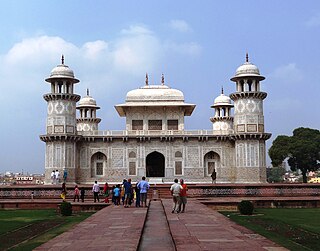
A tomb is a repository for the remains of the dead. It is generally any structurally enclosed interment space or burial chamber, of varying sizes. Placing a corpse into a tomb can be called immurement, although this word mainly means entombing people alive, and is a method of final disposition, as an alternative to cremation or burial.
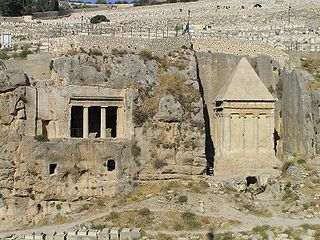
Rock-cut tombs were a form of burial and interment chamber used in ancient Israel. Cut into the landscapes surrounding ancient Judean cities, their design ranges from single chambered, with simple square or rectangular layouts, to multi-chambered with more complex designs. Almost all burial chambers contain a platform for primary burial and an ossuary or other receptacle for secondary burial. There is debate on if these tombs were originally intended for secondary burials, or if that practice arose later.

An ossuary is a chest, box, building, well, or site made to serve as the final resting place of human skeletal remains. They are frequently used where burial space is scarce. A body is first buried in a temporary grave, then after some years the skeletal remains are removed and placed in an ossuary. The greatly reduced space taken up by an ossuary means that it is possible to store the remains of many more people in a single tomb than possible in coffins. The practice is sometimes known as grave recycling.

The Catacombs of Rome are ancient catacombs, underground burial places in and around Rome, of which there are at least forty, some rediscovered only in recent decades.

Saint Peter's tomb is a site under St. Peter's Basilica that includes several graves and a structure said by Vatican authorities to have been built to memorialize the location of Saint Peter's grave. St. Peter's tomb is alleged near the west end of a complex of mausoleums, the Vatican Necropolis, that date between about AD 130 and AD 300. The complex was partially torn down and filled with earth to provide a foundation for the building of the first St. Peter's Basilica during the reign of Constantine I in about AD 330. Though many bones have been found at the site of the 2nd-century shrine, as the result of two campaigns of archaeological excavation, Pope Pius XII stated in December 1950 that none could be confirmed to be Saint Peter's with absolute certainty. Following the discovery of bones that had been transferred from a second tomb under the monument, on June 26, 1968, Pope Paul VI said that the relics of Saint Peter had been identified in a manner considered convincing. Only circumstantial evidence was provided to support the claim.

Tomb KV43 is the tomb of Pharaoh Thutmose IV in the Valley of the Kings in Luxor, Egypt. It has a dog-leg shape, typical of the layout of early 18th Dynasty tombs. KV43 was rediscovered in 1903 by Howard Carter, excavating on behalf of Theodore M. Davis.

A gravedigger is a cemetery worker who is responsible for digging a grave prior to a funeral service.

Beit She'arim necropolis is an extensive necropolis of rock-cut tombs near the remains of the ancient Jewish town of Beit She'arim. In early modern times the site was the Palestinian village of Sheikh Bureik; it was depopulated in the 1920s as a result of the Sursock Purchases, and identified as Beit She'arim in 1936 by historical geographer Samuel Klein.
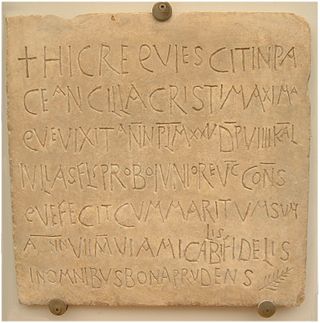
Early Christian inscriptions are the epigraphical remains of early Christianity. They are a valuable source of information in addition to the writings of the Church Fathers regarding the development of Christian thought and life in the first six centuries of the religion's existence. The three main types are sepulchral inscriptions, epigraphic records, and inscriptions concerning private life.
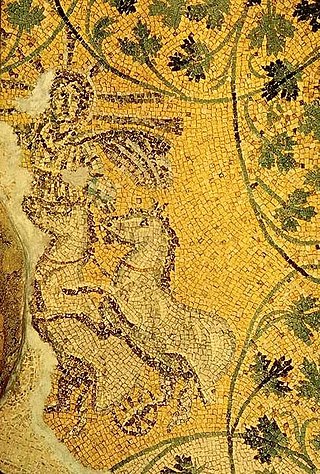
The Vatican Necropolis lies under the Vatican City, at depths varying between 5–12 metres below Saint Peter's Basilica. The Vatican sponsored archaeological excavations under Saint Peter's in the years 1940–1949 which revealed parts of a necropolis dating to Imperial times. The work was undertaken at the request of Pope Pius XI who wished to be buried as close as possible to Peter the Apostle. It is also home to the Tomb of the Julii, which has been dated to the third or fourth century. The necropolis was not originally one of the Catacombs of Rome, but an open-air cemetery with tombs and mausolea.

The Catacomb(s) of Callixtus is one of the Catacombs of Rome on the Appian Way, most notable for containing the Crypt of the Popes, which once contained the tombs of several popes from the 2nd to 4th centuries.

Père Lachaise Cemetery is the largest cemetery in Paris, France, at 44 hectares or 110 acres. With more than 3.5 million visitors annually, it is the most visited necropolis in the world. Notable figures in the arts buried at Père Lachaise include: Jim Morrison, Colette, Michel Ney, Frédéric Chopin, Émile Waldteufel, Édith Piaf, Marcel Proust, Georges Méliès, Marcel Marceau, Olivia de Havilland, Sarah Bernhardt, Oscar Wilde, J. R. D. Tata, Gertrude Stein, Georges Bizet, Gaspard Ulliel, and Sir Richard Wallace.
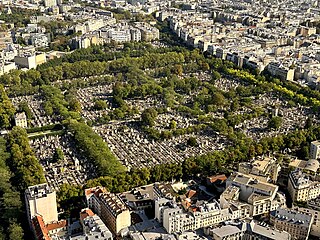
Montparnasse Cemetery is a cemetery in the Montparnasse quarter of Paris, in the city's 14th arrondissement. The cemetery is roughly 47 acres and is the second largest cemetery in Paris. The cemetery has over 35,000 graves and approximately a thousand people are buried here each year.

The Tomb of the Prophets Haggai, Zechariah and Malachi is an ancient burial site located on the upper western slope of the Mount of Olives, Jerusalem. According to a medieval Jewish tradition also adopted by Christians, the catacomb is believed to be the burial place of Haggai, Zechariah and Malachi, the last three Hebrew Bible prophets who are believed to have lived during the 6th–5th centuries BC. Archaeologists have dated the three earliest burial chambers to the first century BC, thus contradicting the tradition.

Jedars are thirteen Berber mausoleums located south of Tiaret city in Algeria. The name is derived from the Arabic: جدار jidār (wall), which is used locally to refer to ancient monumental ruins. The pre-Islamic tombs date from late antiquity.

The Royal Cemetery at Ur is an archaeological site in modern-day Dhi Qar Governorate in southern Iraq. The initial excavations at Ur took place between 1922 and 1934 under the direction of Leonard Woolley in association with the British Museum and the University of Pennsylvania Museum of Archaeology and Anthropology in Philadelphia, Pennsylvania, United States.

The funerary art of ancient Rome changed throughout the course of the Roman Republic and the Empire and took many different forms. There were two main burial practices used by the Romans throughout history, one being cremation, another inhumation. The vessels used for these practices include sarcophagi, ash chests, urns, and altars. In addition to these, mausoleums, stele, and other monuments were also used to commemorate the dead. The method by which Romans were memorialized was determined by social class, religion, and other factors. While monuments to the dead were constructed within Roman cities, the remains themselves were interred outside the cities.
The Hypogeum of Vibia is part of a small complex of pagan burial chambers in Rome which were constructed along the Via Appia in the late 4th century CE. It is named for the burials of a woman named Vibia and her husband Vincentius, a priest of the Thraco-Phrygian god Sabazios. The hypogeum is notable for the paintings that show the deceased figures in mythological scenes and in the underworld, and for their accompanying inscriptions. Numerous other decorated tombs and inscriptions were found in the complex.

The royal necropolis of Byblos is a group of nine Bronze Age underground shaft and chamber tombs housing the sarcophagi of several kings of the city. Byblos is a coastal city in Lebanon, and one of the oldest continuously populated cities in the world. The city established major trade links with Egypt during the Bronze Age, resulting in a heavy Egyptian influence on local culture and funerary practices. The location of ancient Byblos was lost to history, but was rediscovered in the late 19th century by the French biblical scholar and Orientalist Ernest Renan. The remains of the ancient city sat on top of a hill in the immediate vicinity of the modern city of Jbeil. Exploratory trenches and minor digs were undertaken by the French mandate authorities, during which reliefs inscribed with Egyptian hieroglyphs were excavated. The discovery stirred the interest of western scholars, leading to systematic surveys of the site.